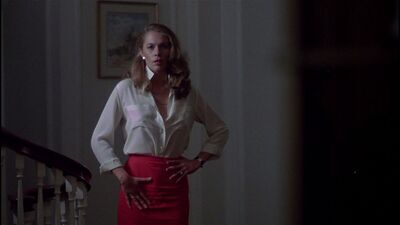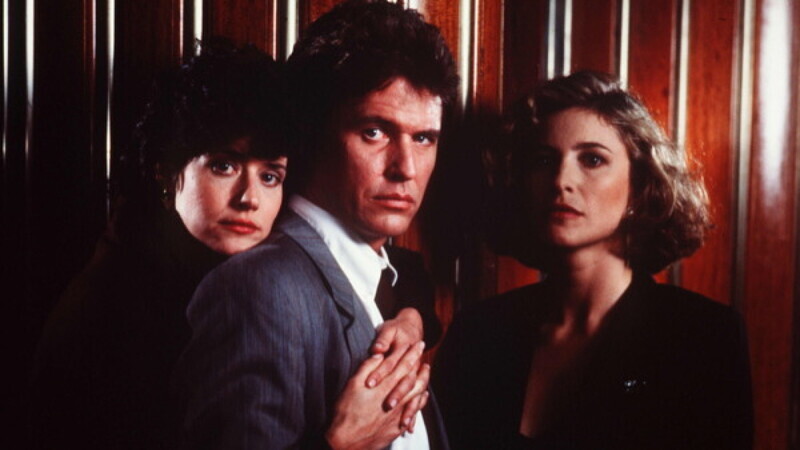The Films of Cocaine Noir

Between the winding down of the first neo-noir cycle popularized by New Hollywood titles like “Chinatown” and “The Long Goodbye,” and before the rise of the erotic thriller as a recognizable genre with entries like “Fatal Attraction” and “Basic Instinct,” there was an entire class of films that had their roots in neo-noir but considerably upped their levels of sex and violence. “Cocaine Noir” might be the best descriptor for them. These films soaked up all the excesses of the eighties and threw them right back in the face of the cheerful Reaganism that was breaking the middle class and poor with the folksiest of smiles. It might have been morning in America, but it was permanently midnight in these films.
1981’s “Body Heat” was an important transitional movie from one decade’s style to the next. One of the last great neo-noirs, it also looks forward to the coming decade with as much interest in sweat glistening on bodies lying on a bed after an illicit tryst as its typically labyrinthe plot. It’s not gunplay in a dark alley that destroys a man’s life, so much as it is a tight red pencil skirt framed against an all-white interior.
Kathleen Turner had a supernova of a star-turn as “Body Heat’s” femme fatale. But three years later she’d be going even further into the knotted web of sex and murder in Ken Russell’s “Crimes of Passion.” The film is not quite a neo-noir, not quite an erotic thriller, and all the cocaine seems to have gone up co-star Anthony Perkins’ nose. “Crimes of Passion””s plot concerns a successful designer (Turner) who moonlights as a sex worker servicing a motley array of lowlifes, the private investigator tagged with following her, and Perkins’ psychotic street preacher obsessed with “saving” her soul at the cost of her own life if necessary.
And yet that description only scratches the surface of how bizarre the film is, as only to be expected with Russell at the helm. Perkins is sweating buckets and terrifying, like a Harry Powell who took the wrong club drugs at a circuit party. The film, however, belongs to Turner. There’s something ugly, dangerous, and unresolvable in her performance and the movie. And as such, something a good deal more honest. There’s the feeling that its real villain is the out of control consumerism of the decade, and how that consumerism leaves everything feeling like not enough, causing people to turn themselves into products.

The idea of the eighties paralleling the actual femme fatale is also keenly felt in Ridley Scott’s “Someone to Watch Over Me.” Mimi Rogers’ heiress, who witnesses a murder, could easily have been set up as the film’s villianess, threatening to break up the marriage of the working class cop (Tom Berenger) assigned to protect her. But the film is much more interesting than that. Helplessly out of place in the spectacular interiors of Rogers’ penthouse, Berenger begins to fall for her. And she falls for him in turn because Berenger is not yet another walking MBA she constantly rubs elbows with at museum galas.
The film is understanding of their affair while never letting him off the hook for what a profound betrayal of trust it is for his wife (Lorraine Bracco). Bracco’s performance is the secret beam supporting the film from collapsing into a mere Town & Country spread. She’s earthy and vulgar mouthed, not as a justification for why Berenger should have taken up with Rogers, but in showing what a good match they were. And why they would return to each other after the climax of the film. Rogers leaves the film alone, and her tragedy is that the splendor of her lifestyle has snuffed any chance at real connection. Scott films ’80s Manhattan in “Someone to Watch Over Me” as a beautifully gloomy place. The basements of its groaning skyscrapers look like the interiors of the Nostromo in “Alien.” In such a hostile to life environment, marriage becomes one of its few safe harbors.

But if marriage can provide a sense of safety, it’s equally able to become a nightmare of violence. The same year’s “White of the Eye” was a dazzling desert thriller in which a woman (Cathy Moriarty) begins to suspect her husband may be a serial killer. The film has a keen understanding that when you find out someone you love has done something terrible, oftentimes you don’t stop loving them, which makes it all the worse. Moriarty’s sensitive, highly receptive performance keeps the film’s feelings and images from the clinical chic of a gallery show, and turn it into something much more profound about the terrible bargains women make to exist in this world.
1987 was also the year of “Fatal Attraction.” In that film, the other woman was most definitely the villain, and she was dispatched in the film’s climax in a welter of violence. “Fatal Attraction” was a massive hit and inaugurated a new cycle of stories that fed America’s twin obsessions: the desire to see sexual activity and the desire to see people punished for it. Erotic thrillers are a fascinating genre in their own right, often telling things a lot more honestly about American sexual appetites and sexism than they intend to. But they quickly hardened into formula. Cocaine Noir by its nature was a genre chameleon. “White of the Eye” constantly unsettles the viewer by shimmering its feral skin into a slasher, then an indie drama, then an experimental film, or sometimes all at once.
They also never lost their political teeth the way erotic thrillers could, and the way the ’90s cycle of suspense pictures perhaps best described as “wealthy white people in danger” did. The Clintonian atomization of society seeping down into the popular films, where there was no larger society to fail you but your perfect suburban enclave or co-op, could be threatened by the nanny from hell in “The Hand That Rocks The Cradle” or the neighbor from hell in “Pacific Heights.”

It’s not that these films were apolitical, but they showed how the larger culture had fully bought into the idea that systemic failures were personal failings. Cocaine Noir was always willing to point the finger at things like capitalism or at an out of control police force like in Mike Figgis’ “Internal Affairs.” In that film, Richard Gere’s crooked cop effectively uses the LAPD as his own private security detail against the internal affairs investigator determined to bring him down. And in Jerry Schatzberg’s “Street Smart,” it’s the twin engines of gentrification and journalism that turn crime into entertainment for yuppie readers, as a hungry reporter invents a story and gets a lot of people killed in the process.
Cocaine Noir highlights the great mistake of the present to assume the past accepted all of their eras’ cruelties and unhealthy obsessions uncritically. It’s one of many examples that the Pepsi Generation decade understood the rot at its core. Cocaine Noir knew that if there’s a constant in human behavior, it’s how we want what we know is no good for us. That was as true in the eighties as it is now.





